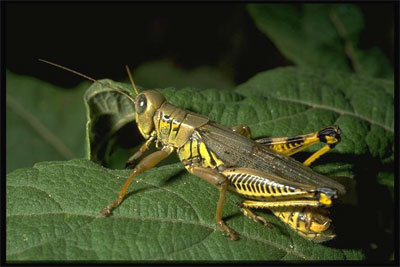Garden Tip from May 28

Differential grasshopper, Melanoplus differentialis (Thomas) (Orthoptera: Acrididae). Photo by Drees.
Grasshoppers are running rampant in parts of Texas already. Warm fall weather followed by cool springs will lead to their increases. Sound familiar? Also, they will be much worse near tall grass and weeds. Eliminate those if you have access to them. Baits are not effective enough quickly enough to offer the kind of help most people seek. Spray with a labeled insecticide in a downward sweep, so you will hit them as they try to fly away. Almost all plants become attractive to them, particularly after they have devoured their preferred crops and succulent vegetation.
I’m going to turn you over now to the professional entomologists — the experts. Here are several university websites. Some of the control products are somewhat out-of-date, as ingredients have changed, but the basic information is critical to coping with these pests.
This piece by my friend and very fine entomologist Dr. Mike Merchant is very useful. It is, however, 10 years old in terms of the controls it suggests. The information on habitats, breeding, etc., is invaluable. http://citybugs.tamu.edu/factsheets/landscape/lawns/ent-1005/
This TAMU Extension Service website has a PDF document that you can download and print at no charge. It’s quite thorough, and it shows outstanding photos of the grasshoppers that do 95 percent of the damage in Texas. However, it’s more directed at farmers and ranchers, and it’s also about 10 years old, so the control products have changed.
Somewhat more current: this publication from the University of Nebraska, also a PDF. http://www.ianrpubs.unl.edu/epublic/live/g1633/build/g1633.pdf
I’ve spent 45 minutes searching for the best, most up-to-date university information, and these are what I would put at the top of the stack.
I would suggest that you control outbreaks early, before populations and damage build. Talk to a Texas Master Certified Nursery Professional about your next best step. He or she will have products to discuss with you, and will be well-versed about grasshopper populations in your area.

